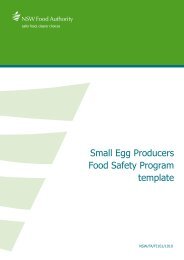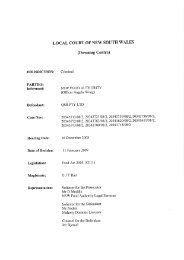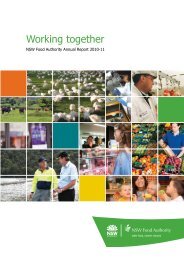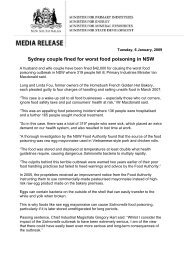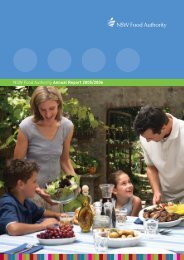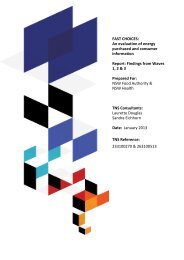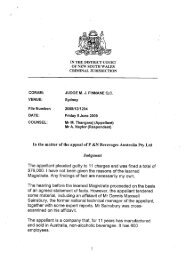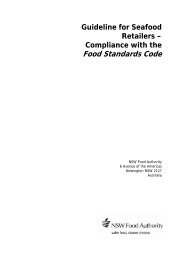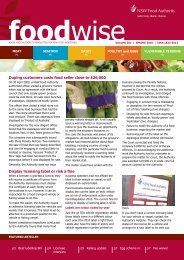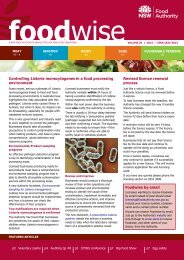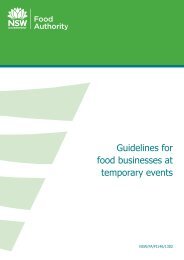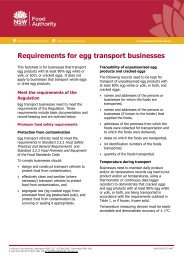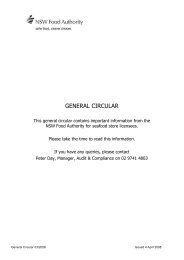Imported food must be labelled correctly - NSW Food Authority
Imported food must be labelled correctly - NSW Food Authority
Imported food must be labelled correctly - NSW Food Authority
- No tags were found...
Create successful ePaper yourself
Turn your PDF publications into a flip-book with our unique Google optimized e-Paper software.
<strong>Imported</strong> <strong>food</strong> <strong>must</strong> <strong>be</strong> la<strong>be</strong>lled <strong>correctly</strong>Article submitted to The Australian Chinese Daily, May 2012All <strong>food</strong> sold in Australia–whether by importers, distributors, manufacturers, wholesalers or retailers–<strong>must</strong> <strong>be</strong> la<strong>be</strong>lled <strong>correctly</strong> and list the ingredients. This is a requirement under the Australia and NewZealand <strong>Food</strong> Standards Code (<strong>Food</strong> Standards Code).<strong>Food</strong> la<strong>be</strong>ls <strong>must</strong> not <strong>be</strong> altered, removed or obscured, unless permitted by the <strong>NSW</strong> <strong>Food</strong> <strong>Authority</strong> orwhere a package of <strong>food</strong> may require rela<strong>be</strong>lling with the correct information to meet Australianrequirements. For example, where a la<strong>be</strong>l is not in English, or the Nutrition Information Panel (NIP) isnot compliant, the package can <strong>be</strong> rela<strong>be</strong>lled with the correct information.Compositional requirements‘Product composition’ refers to the ingredients (or additives) in a <strong>food</strong>. Ingredients need to <strong>be</strong> listed onthe la<strong>be</strong>l in descending order, from greatest to smallest, according to how much they weigh when addedto the product.A ‘composite ingredient’ may <strong>be</strong> one of several main ingredients in a product. If a composite ingredientcontains small amounts of other ingredients (
Declaration of allergenic substancesEight <strong>food</strong>s cause around 90% of <strong>food</strong> allergic reactions. They are peanuts, tree nuts (eg almonds andcashews), eggs, milk, fish, crustacean (eg prawns, lobster), sesame and soy. Importers <strong>must</strong>, by law,declare these <strong>food</strong>s, and the products that include them, in the ingredients list on la<strong>be</strong>ls. Gluten andsulphites <strong>must</strong> also <strong>be</strong> declared on la<strong>be</strong>ls.Country of origin informationA statement on the package <strong>must</strong> clearly identify where the <strong>food</strong> was made or produced, or packagedfor retail sale. It <strong>must</strong> also state whether the packaged <strong>food</strong> contains imported ingredients or localingredients, or a mixture of both.Lot identificationA ‘lot’ is when <strong>food</strong> is prepared or packed under the same conditions, usually a certain preparation orpacking unit, and for a set time (not exceeding 24 hours).‘Lot identification’ refers to the information on the la<strong>be</strong>l that identifies the premises where the <strong>food</strong> wasprepared or packed, and the relevant lot of <strong>food</strong>.Failure to include lot identification is an increasingly common breach among importers trying to sell<strong>food</strong>s in Australia that have <strong>be</strong>en manufactured for sale in another country and often do not meetAustralian la<strong>be</strong>lling requirements. Generally, an importer can add new lot identification provided theaddition occurs with the permission of the <strong>NSW</strong> <strong>Food</strong> <strong>Authority</strong> or as a result of rela<strong>be</strong>lling of anincorrect la<strong>be</strong>l, and the new lot identification indicates the premises where the <strong>food</strong> was packed orprepared and the ‘lot’ of the <strong>food</strong> in question.Fines can <strong>be</strong> imposed for incorrect la<strong>be</strong>llingIf <strong>food</strong> is sold that does not comply with the requirements of the <strong>Food</strong> Standards Code, an individualcan <strong>be</strong> fined $55,000 and a corporation can <strong>be</strong> fined $275,000.Where to find more information1. FSANZ, <strong>Food</strong> Standards Code• Part 1.2 – La<strong>be</strong>lling• Part 1.3 – Permitted additives and nutritive substances• Part 1.4 – Prohibited and restricted plants and fungi• Part 1.5 – Novel <strong>food</strong>s2. FSANZ, Code Interpretation Service (CIS)3. <strong>NSW</strong> <strong>Food</strong> <strong>Authority</strong>• Website: www.<strong>food</strong>authority.nsw.gov.au• Helpline: 1300 552 406Page 2 of 2



